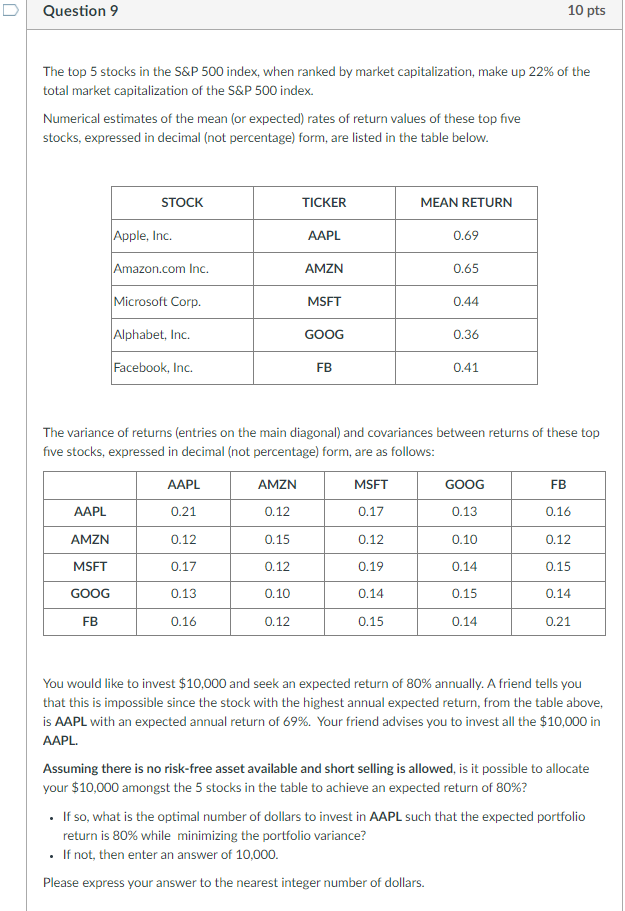
D Question 9 10 pts The top 5 stocks in the S&P 500 index, when ranked by market capitalization, make up 22% of the total market capitalization of the S&P 500 index. Numerical estimates of the mean (or expected) rates of return values of these top five stocks, expressed in decimal (not percentage) form, are listed in the table below. STOCK TICKER MEAN RETURN Apple, Inc. AAPL 0.69 Amazon.com Inc. AMZN 0.65 Microsoft Corp. MSFT 0.44 Alphabet, Inc. GOOG 0.36 Facebook, Inc. FB 0.41 The variance of returns (entries on the main diagonal) and covariances between returns of these top five stocks, expressed in decimal (not percentage) form, are as follows: AAPL AMZN MSFT GOOG FB AAPL 0.21 0.12 0.17 0.13 0.16 AMZN 0.12 0.15 0.12 0.10 0.12 MSFT 0.17 0.12 0.19 0.14 0.15 GOOG 0.13 0.10 0.14 0.15 0.14 FB 0.16 0.12 0.15 0.14 0.21 You would like to invest $10,000 and seek an expected return of 80% annually. A friend tells you that this is impossible since the stock with the highest annual expected return, from the table above, is AAPL with an expected annual return of 69%. Your friend advises you to invest all the $10,000 in AAPL. Assuming there is no risk-free asset available and short selling is allowed, is it possible to allocate your $10,000 amongst the 5 stocks in the table to achieve an expected return of 80%? If so, what is the optimal number of dollars to invest in AAPL such that the expected portfolio return is 80% while minimizing the portfolio variance? If not, then enter an answer of 10,000. Please express your answer to the nearest integer number of dollars. D Question 9 10 pts The top 5 stocks in the S&P 500 index, when ranked by market capitalization, make up 22% of the total market capitalization of the S&P 500 index. Numerical estimates of the mean (or expected) rates of return values of these top five stocks, expressed in decimal (not percentage) form, are listed in the table below. STOCK TICKER MEAN RETURN Apple, Inc. AAPL 0.69 Amazon.com Inc. AMZN 0.65 Microsoft Corp. MSFT 0.44 Alphabet, Inc. GOOG 0.36 Facebook, Inc. FB 0.41 The variance of returns (entries on the main diagonal) and covariances between returns of these top five stocks, expressed in decimal (not percentage) form, are as follows: AAPL AMZN MSFT GOOG FB AAPL 0.21 0.12 0.17 0.13 0.16 AMZN 0.12 0.15 0.12 0.10 0.12 MSFT 0.17 0.12 0.19 0.14 0.15 GOOG 0.13 0.10 0.14 0.15 0.14 FB 0.16 0.12 0.15 0.14 0.21 You would like to invest $10,000 and seek an expected return of 80% annually. A friend tells you that this is impossible since the stock with the highest annual expected return, from the table above, is AAPL with an expected annual return of 69%. Your friend advises you to invest all the $10,000 in AAPL. Assuming there is no risk-free asset available and short selling is allowed, is it possible to allocate your $10,000 amongst the 5 stocks in the table to achieve an expected return of 80%? If so, what is the optimal number of dollars to invest in AAPL such that the expected portfolio return is 80% while minimizing the portfolio variance? If not, then enter an answer of 10,000. Please express your answer to the nearest integer number of dollars







